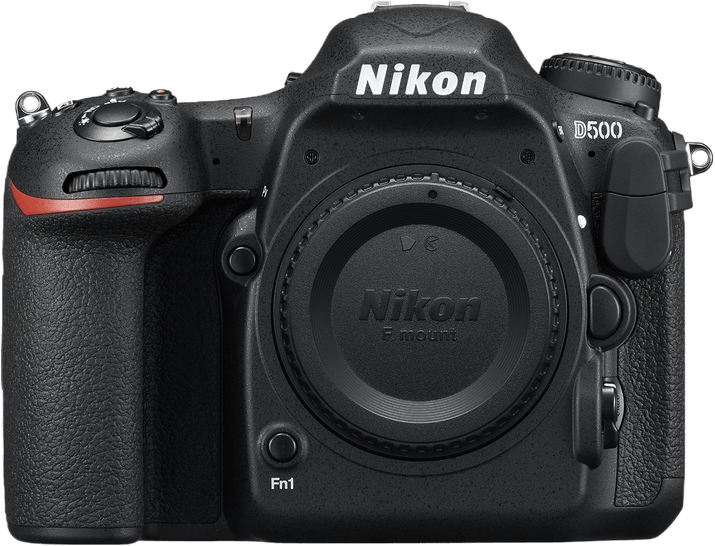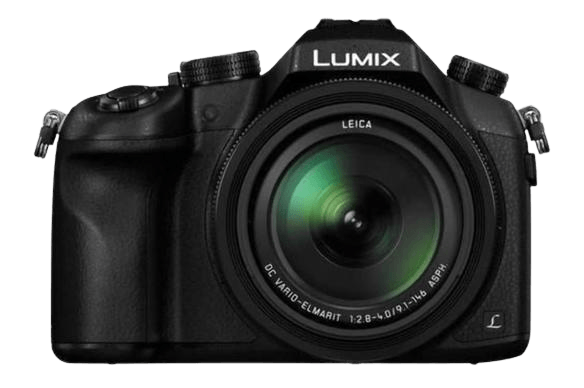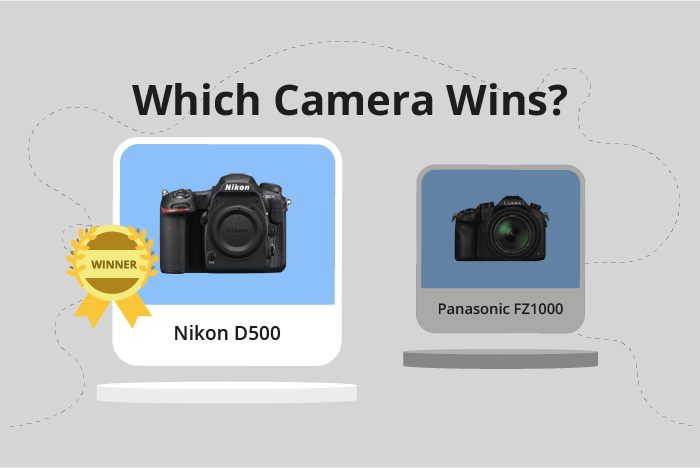Nikon D500 vs Panasonic Lumix DMC-FZ1000 Comparison
Nikon D500

Panasonic Lumix DMC-FZ1000

The Nikon D500 outperforms the Panasonic Lumix DMC-FZ1000 with a score of 75/100 compared to 57/100. Both cameras were released two years apart, with the D500 in 2016 and the FZ1000 in 2014. They share similarities in size and weight, with the D500 measuring 147 x 115 x 81mm and weighing 860g, while the FZ1000 measures 137 x 99 x 131mm and weighs 831g.
The D500’s higher score reflects its superior performance as a DSLR camera, justifying its launch price of $2000 compared to the FZ1000’s $899. However, the FZ1000, as a bridge camera, offers a more affordable option for those with a tighter budget.
Considering these specifications, the Nikon D500 is the clear winner for those seeking advanced features and performance, while the Panasonic Lumix DMC-FZ1000 remains a viable choice for those looking for a more budget-friendly option.
Nikon D500 vs Panasonic Lumix DMC-FZ1000 Overview and Optics
The Nikon D500 outperforms the Panasonic Lumix DMC-FZ1000 in optics with a score of 69/100 compared to the Panasonic’s 61/100. Both cameras share similarities such as having CMOS sensors, 20+ megapixels, and shooting speeds of 10 and 12 fps for the Nikon and Panasonic, respectively.
The Nikon D500’s higher score is due to its superior sensor, boasting an APS-C sensor size and an 84 DXOMARK score. This larger sensor allows for better image quality, especially in low-light situations. Additionally, the Nikon D500 uses the Expeed 5 processor and has a Nikon F DX lens mount, providing users with a wide variety of lens options to choose from. However, the Nikon D500 lacks image stabilization, which can be crucial for certain types of photography.
On the other hand, the Panasonic Lumix DMC-FZ1000 has a smaller 1″ sensor with a lower DXOMARK score of 64, resulting in lower image quality compared to the Nikon D500. The Panasonic also uses a fixed lens mount, limiting users to the built-in lens. However, the Panasonic Lumix DMC-FZ1000 has a faster shooting speed of 12 fps and includes image stabilization, making it better suited for action photography and videography.
In comparing the optics of these two cameras, the Nikon D500’s larger sensor size and greater lens options make it the superior choice for photographers who prioritize image quality and versatility. The Panasonic Lumix DMC-FZ1000, while not as strong in optics, offers advantages in shooting speed and image stabilization, which could be preferable for specific situations or users.
Nikon D500 vs Panasonic Lumix DMC-FZ1000 Video Performance
The Panasonic Lumix DMC-FZ1000 outperforms the Nikon D500 in video capabilities, boasting a video score of 83/100 compared to the Nikon’s 70/100. Both cameras offer 4K video resolution with maximum video dimensions of 3840 x 2160 and built-in time-lapse functionality. However, there are significant differences that make the Panasonic Lumix DMC-FZ1000 a superior choice for video recording.
The most notable advantage of the Panasonic Lumix DMC-FZ1000 is its higher video frame rate of 60fps, double the Nikon D500’s 30fps. This higher frame rate allows for smoother video playback and better slow-motion capabilities, making it more suitable for capturing fast-moving subjects and action scenes.
While the Nikon D500 does not surpass the Panasonic Lumix DMC-FZ1000 in any video-related specifications, it still offers respectable video quality with its 4K resolution and time-lapse functionality. It is important to remember that the Nikon D500 is not a poor choice for video recording; it is simply outperformed by the Panasonic Lumix DMC-FZ1000 in this specific aspect.
Considering the video capabilities of both cameras, the Panasonic Lumix DMC-FZ1000 emerges as the better option for those prioritizing video recording, thanks to its higher video score, smoother frame rate, and superior slow-motion capabilities. The Nikon D500, while not as strong in the video department, still provides good video quality and should not be dismissed entirely for this purpose. Ultimately, the choice between these two cameras will depend on the user’s specific needs and preferences.
Nikon D500 vs Panasonic Lumix DMC-FZ1000 Features and Benefits
The Nikon D500 leads in the comparison with a feature score of 87/100, while the Panasonic Lumix DMC-FZ1000 trails behind with a score of 58/100. Both cameras share some common specifications, such as screen resolution at 2,359,000 dots, flip screen, absence of GPS, and the presence of WIFI and Bluetooth connectivity.
The Nikon D500 surpasses the Panasonic Lumix DMC-FZ1000 in several aspects. The D500 has a larger screen size of 3.2 inches compared to the FZ1000’s 3-inch screen. Additionally, the D500 features a touchscreen, making it more user-friendly and efficient in navigating through settings and reviewing images.
On the other hand, the Panasonic Lumix DMC-FZ1000 has a few advantages over the Nikon D500. It is lighter and more compact, making it a more portable option for photographers who prioritize convenience and mobility. However, this advantage does not outweigh the benefits offered by the Nikon D500.
In comparing the features of these two cameras, the Nikon D500 clearly outperforms the Panasonic Lumix DMC-FZ1000 with a higher feature score, larger screen size, and the presence of a touchscreen. The FZ1000’s advantage in terms of portability is not enough to make up for the D500’s superior features. As a result, the Nikon D500 emerges as the superior camera in this comparison.
Nikon D500 vs Panasonic Lumix DMC-FZ1000 Storage and Battery
The Nikon D500 outperforms the Panasonic Lumix DMC-FZ1000 in storage and battery with a score of 79/100, a significant 58-point difference from the FZ1000’s score of 21/100. Both cameras share compatibility with SD, SDHC, and SDXC memory cards and lack USB charging capabilities.
The D500 offers more convenience with its dual memory card slots (SD/SDHC/SDXC UHS-II compatible and XQD) compared to the FZ1000’s single slot. Additionally, the Nikon D500 boasts an impressive battery life of 1240 shots with its EN-EL15 battery, far surpassing the FZ1000’s 360 shots using the DMW-BLC12PP battery.
While the FZ1000 does not outshine the D500 in this category, it still provides adequate storage and battery capabilities for casual photographers.
Considering the significant advantages in storage and battery life, the Nikon D500 is the clear winner in this comparison, making it a more suitable choice for professionals and enthusiasts who require greater storage flexibility and longer shooting sessions. On the other hand, the Panasonic Lumix DMC-FZ1000 remains a viable option for casual users who do not heavily rely on storage and battery performance.
Nikon D500 vs Panasonic Lumix DMC-FZ1000 – Our Verdict
Are you still undecided about which camera is right for you? Have a look at these popular comparisons that feature the Nikon D500 or the Panasonic Lumix DMC-FZ1000:

